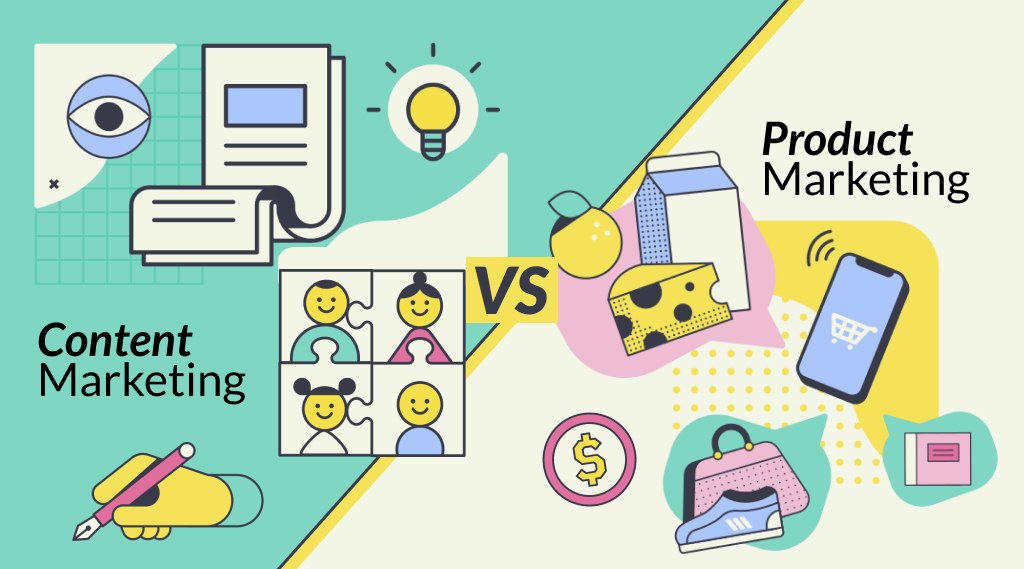Imagine you’re exploring a new fitness app that offers personalized workout plans. As you scroll through their detailed blog posts about the benefits of interval training and yoga for mental health—these are prime examples of content marketing.
Then, you receive a push notification introducing their premium subscription service, complete with advanced tracking features. This is what we call product marketing.
While they both aim to attract and convert members of your target audience into paying customers, they serve distinct purposes and employ different tactics
In this article, we will understand the differences between content marketing and product marketing, and how they can complement each other in a comprehensive marketing strategy.
We’ll cover:
- What is content marketing?
- What is product marketing?
- Content marketing vs. product marketing
- Combining content and product marketing
By the end of this article, you’ll have a clear understanding of the unique roles that content marketing and product marketing play in driving business success and how to leverage them effectively in your marketing efforts.
Let’s dive in!
What is content marketing?
Content marketing is a strategic marketing approach focused on creating and distributing valuable, relevant, and consistent content to attract and retain a clearly defined audience — and, ultimately, to drive profitable customer action.
Instead of directly promoting a brand, product, or service, content marketing aims to provide useful information, entertain, or educate the audience, thereby building trust and establishing the brand as a thought leader in its industry.
Advantages of content marketing include:
- Building trust and credibility
- Increasing brand awareness
- Generating leads and sales
- Improving search engine rankings
- Enhancing customer engagement and loyalty
- Content marketing channels
Content marketing channels vary depending on the target audience and the type of content being created.
Content marketing channels
Some common content marketing channels include:
- Blogs: Company blogs are a popular channel for content marketing, allowing brands to publish articles, how-to guides, case studies, and other types of written content.
- Social media: Platforms like Facebook, Twitter, LinkedIn, Instagram, and YouTube provide opportunities for brands to share content, engage with their audience, and increase brand awareness.
- Email marketing: Email newsletters and campaigns can be used to deliver valuable content directly to subscribers’ inboxes, nurturing leads and keeping customers informed about new products or services.
- Video content: With the increasing popularity of platforms like YouTube and TikTok, video content has become a powerful tool for content marketing, allowing brands to engage their audience through tutorials, product demos, interviews, and more.
- Podcasts: Podcasts offer a convenient way for brands to share valuable content with their audience while they’re on the go, allowing for deeper engagement and building brand loyalty.
- Infographics and Visual content: Infographics, images, and other visual content can be highly shareable and effective in conveying complex information in a visually appealing way.
- Webinars and events: Hosting webinars, workshops, and other virtual or in-person events can be an effective way to deliver valuable content, engage with the audience, and generate leads.
These are just a few examples of content marketing channels, and the most effective channels for a particular brand will depend on its target audience, industry, and marketing objectives.
Now that we know about content marketing lets shift to product marketing and see its capabilities.
What is product marketing?
Product marketing is a subset of marketing that focuses specifically on promoting and selling a particular product or service to a target audience. It involves creating and implementing strategies to effectively market and position the product in the market, differentiate it from competitors, and drive sales.
Advantages of product marketing include:
- Increased sales
- Better understanding of the target audience
- Improved product positioning
- Enhanced brand awareness
- Higher customer satisfaction
- Product marketing channels
Product marketing channels
Product marketing channels refer to the various channels and platforms through which product marketing efforts are carried out. These can include:
- Digital marketing channels
- Traditional marketing channels
- Retail channels
- Influencer marketing
- Public Relations (PR)
Digital marketing channels
This includes online platforms such as websites, social media, email marketing, search engine optimization (SEO), and online advertising.
Traditional marketing channels
This includes offline channels such as print advertising, television and radio commercials, direct mail, and outdoor advertising.
Retail channels
This includes distribution channels such as brick-and-mortar stores, online retailers, wholesalers, and distributors through which the product is sold to consumers.
Influencer marketing
This involves partnering with influencers or key opinion leaders who have a large following and credibility in a particular niche to promote the product to their audience.
Public relations (PR)
This involves managing the public image and reputation of the product through media relations, press releases, events, and other PR activities.
Overall, product marketing channels can vary depending on the target audience, industry, and marketing objectives, and a successful product marketing strategy often involves a combination of different channels to reach and engage with consumers effectively.
Let us understand how both of them are different from each other.
How is content marketing different from product marketing?
Content marketing and product marketing are both important aspects of a comprehensive marketing strategy, but they serve different purposes and focus on different aspects of the marketing process.
Let us understand the difference between both of them in detail:
| Aspect | Content Marketing | Product Marketing |
| Focus | Primarily focuses on creating and distributing valuable, relevant, and consistent content to attract and engage a target audience. | Primarily focuses on promoting and selling a specific product or service to a target audience. |
| Objective | Aims to educate, entertain, or inform the audience without directly promoting a product or service. | Aims to drive sales, increase demand, and promote a particular product or service. |
| Content types | Content can include blog posts, articles, videos, podcasts, infographics, eBooks, etc. | Content can include product descriptions, product demos, case studies, customer testimonials, comparison charts, etc. |
| Audience interaction | Focuses on building relationships with the audience by providing valuable content that addresses their needs and interests. | Focuses on persuading the audience to purchase the product by highlighting its features, benefits, and unique value proposition. |
| Sales process | Content marketing typically occurs earlier in the sales funnel, aiming to attract and engage potential customers, often before they’re ready to make a purchase decision. | Product marketing typically occurs later in the sales funnel, aiming to convert leads into customers and drive sales of a specific product or service. |
| Metrics | Metrics may include website traffic, engagement metrics (likes, shares, comments), email open rates, lead generation, etc. | Metrics may include sales revenue, conversion rates, customer acquisition cost (CAC), customer lifetime value (CLV), market share, etc. |
| Relationship with product | Content may indirectly support product marketing efforts by building brand awareness, credibility, and trust among the audience. | Product marketing directly promotes and sells a specific product or service, often leveraging content marketing to support its objectives. |
How does content marketing and product marketing work together?
In the bustling arena of marketing strategies, two heavyweights step into the ring: Content Marketing and Product Marketing.
They might sound similar, but make no mistake; they’re the Batman and Robin of the marketing world—distinct in their approaches yet vital for a brand’s success.
Content marketing: The storyteller
- What it’s all about: Content Marketing is like the friendly storyteller in your favorite book. It crafts engaging tales through blogs, videos, and social media, not necessarily screaming, “Buy me!” but rather, “Let’s be friends.” The goal is to create a lasting connection by providing valuable, relevant content that your audience loves.
- Main focus: Building relationships, establishing brand identity, and offering useful information.
- Timeline: Think of it as a slow burn. Content Marketing is a long-term investment that gradually builds trust and loyalty.
Product marketing: The showstopper
- What it’s all about: Product marketing is the superhero that swoops in when it’s time to shine the spotlight on your product. It’s the guide that highlights why your product is the answer to your customer’s needs, using catchy descriptions and persuasive tactics.
- Main Focus: Driving sales by showcasing the unique features and benefits of your product. It’s the push your audience needs to make that purchase.
- Timeline: It’s the sprinter in the marketing race. Product Marketing aims for a quick impact, nudging the customer towards the checkout.
The tag team effect: When both unite?
While they each have their spotlight moments, Content Marketing and Product Marketing are a dynamic duo when combined. Content sets the stage, creating a receptive audience, and Product Marketing swoops in for the grand finale, turning interest into action.
In the grand scheme of things, understanding the dance between Content Marketing and Product Marketing is like having both Batman and Robin on your side—a winning combination for navigating the intricate world of digital marketing. As we peel back the layers, we’ll uncover how this tag team strategy can propel your brand to new heights in the online arena.
Conclusion
Content marketing and product marketing serve different purposes, they are both vital to the success of any business aiming to engage and convert their target audience. When synchronized effectively, these strategies can dramatically amplify your market presence and customer conversion rates.
Curious about how to effectively integrate content marketing with product marketing? Let us help you strike the perfect balance and achieve your marketing objectives.
Check out our product marketing services to see how we can simplify your marketing processes and enhance your inbound conversion rates. Whether it’s optimizing content strategies or boosting product promotions, our solutions are designed to meet your specific needs. Reach out to us today to learn more!



